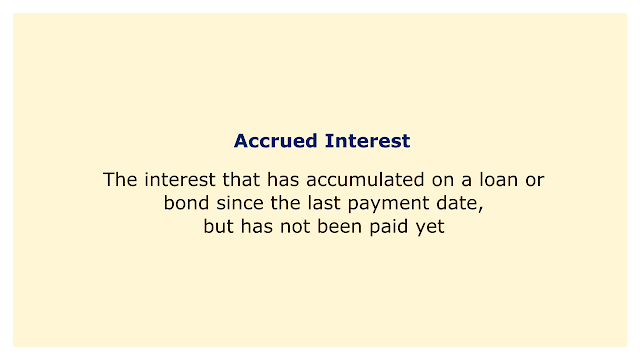 |
| Image: Moneybestpal.com |
Accrued interest is a concept that applies to both accounting and bond trading. It describes the interest that has accrued but not yet been paid on a loan or bond since the last payment date.
The sum of the principle, the interest rate, and the number of days since the last payment are used to calculate accrued interest.
At the conclusion of each reporting period, accrued interest is reported in accounting as an adjusting entry. According to the accrual principle, revenues and expenses should be recorded as they are incurred rather than as money is exchanged. Both the borrower's and the lender's balance sheets are impacted by accrued interest.
As an illustration, let's say that on March 21, a business borrowed $100,000 from a bank at a 6% annual interest rate, with the agreement to pay back the loan with interest on the twentieth of each month. April 20 is the due date for the initial interest payment. (100,000 x 6% / 12) = $500 in interest per month.
The corporation accrued interest for 10 days, or $166.67 ($500 x 10 / 30), on March 31, the last day of the accounting period. On the income statement and balance sheet of the business, respectively, this is listed as an interest expenditure and an accrued interest payment. On the income statement and balance sheet of the bank, respectively, this is listed as interest income and accrued interest receivable.
Accrued interest in bond trading refers to the interest that the bond buyer owes to the bond seller. Bonds can be exchanged on the market at any time and typically pay interest on set dates every six months to a year. The portion of the interest that has accrued since the last coupon date must be paid to the seller when a bond is exchanged between coupon days.
Consider a bond with a $1,000 face value that pays a 5% annual coupon twice a year, on June 1 and December 1. A buyer buys the bond from a seller on September 15. From June 1, interest on the bond has accumulated for 106 days, or $14.58 ($1,000 x 5% x 106 / 365). This sum is paid by the buyer to the seller in addition to the bond's purchase price. On December 1, the purchaser will get the entire $25 coupon payout.
Accrued interest in bond trading refers to the interest that the bond buyer owes to the bond seller. Bonds can be exchanged on the market at any time and typically pay interest on set dates every six months to a year. The portion of the interest that has accrued since the last coupon date must be paid to the seller when a bond is exchanged between coupon days.
Consider a bond with a $1,000 face value that pays a 5% annual coupon twice a year, on June 1 and December 1. A buyer buys the bond from a seller on September 15. From June 1, interest on the bond has accumulated for 106 days, or $14.58 ($1,000 x 5% x 106 / 365). This sum is paid by the buyer to the seller in addition to the bond's purchase price. On December 1, the purchaser will get the entire $25 coupon payout.
